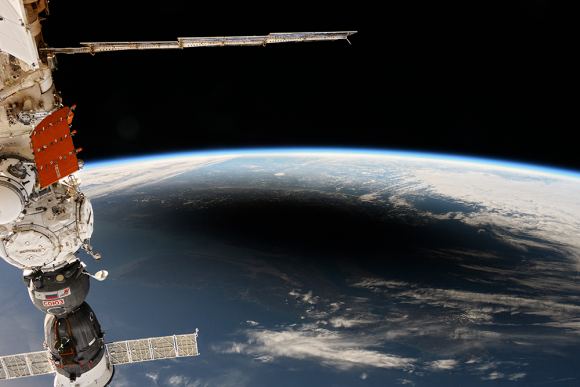It’s been just over a week since millions of people flocked to places across North America for a glimpse of moonshadow. The total solar eclipse of April 8th, 2024 was a spectacular sight for many on the ground. From space, however, it was even more impressive as Earth-observing satellites such as GOES-16 captured the sight of the shadow sweeping over Earth.
NASA even got a snap of the eclipse from the Moon, as taken by the Lunar Reconnaissance Orbiter Camera (LROC). Unlike most Earth-based photographers, however, LROC’s view was a tricky one to get. The cameras are line scanners and their images get built up line-by-line. That process requires the spacecraft to slew to keep up with the action and build up a complete view. Amazingly, it took only 20 seconds to capture all the action.
A short video of the eclipse shadow along the path of totality, captured by NASA’s Deep Space Climate Observatory.NASA’s Deep Space Climate Observatory got an amazing view from Earth orbit, capturing the entire eclipse as it passed over the continent. That observatory “lives” out at LaGrange Point 1, which enabled it to get a full view of Earth and the Moon’s shadow.
For most viewers, the chase to see an eclipse meant driving (or flying) to somewhere along the path of totality to get the best view. That path stretched from the Pacific Ocean off the coast of Mexico up toward the northern Canadian provinces. That meant a wide swath of the U.S. experienced totality. Or course, the weather had to be good to see it all. In most places, that actually turned out reasonably well. Social media immediately came alive with images of the eclipse, people enjoying it, and others waiting vainly for a break in the clouds.
 A composite of images taken during the total solar eclipse showing all the phases leading up to and after totality. NASA/Keegan Barber.
A composite of images taken during the total solar eclipse showing all the phases leading up to and after totality. NASA/Keegan Barber.
This writer was stationed off the coast of Mazatlán, Mexico, on a cruise ship with a group of amateur and professional astronomers. Although there were a few clouds, the view of the eclipsed Sun was nearly pristine. From the ship, everyone was able to watch the shadow approach, feel the temperature drop, and marvel at 4 minutes and 20 seconds of totality.
 A projection of the partially eclipsed Sun on the stack of a cruise ship off the coast of Mazatlan. Image credit: Carolyn Collins Petersen.
A projection of the partially eclipsed Sun on the stack of a cruise ship off the coast of Mazatlan. Image credit: Carolyn Collins Petersen.
In a few regions, however, people were only able to watch clouds get dark. And, for the majority of viewers outside of the path of totality, they could only get a partial view. Still, in many places, people went out to experience the event using eclipse glasses or pinhole projection methods to see those partial phases.
For those who could “fly the eclipse” it was an opportunity to take a jet plane along the path and prolong the experience. During the eclipse, flight-tracking apps showed a huge increase in traffic along the path. Several airlines had flights that tracked the path, giving lucky passengers the view of a lifetime for a short period.
 A pilot flying a WB-57 jet during the total solar eclipse on April 8, 2024. Credit: NASA/Mallory Yates
A pilot flying a WB-57 jet during the total solar eclipse on April 8, 2024. Credit: NASA/Mallory YatesAt least one NASA jet pilot captured a view as the aircraft passed through the shadow. In space, the astronauts aboard the International Space Station got a great shot of the umbra and penumbra passing over the maritime provinces of Canada.
 A view of the eclipse shadow from the International Space Station. Courtesy NASA.
A view of the eclipse shadow from the International Space Station. Courtesy NASA.
The 2024 eclipse across North America left many with a taste for more moonshadow experience. Unfortunately, that was the last one for this part of the world until 2045. That’s when another one will sweep across the continent. Before that, however, there are other total solar eclipses, as well as lunar and annular events. The years 2026, 2027, and 2028 will feature totalities across parts of Europe, Egypt, and Australia. You can find out locations and dates for others at Mr. Eclipse, as well as NASA’s own eclipse site. For each event, there’ll be plenty of information about safe viewing, as well as “broadcasts” on social media for those outside of the paths of totality.
For More Information
2024 Eclipse as Seen From The Moon
The April 8 Total Solar Eclipse: Through the Eyes of NASA

